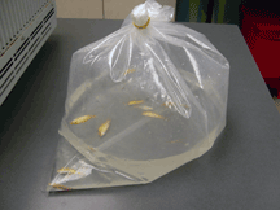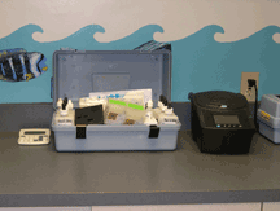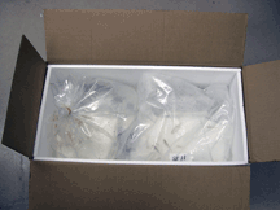Please speak to someone in the diagnostic lab before collecting and packing samples for the lab. Talking to us ahead of time allows us to discuss which specimens would be best, how many we need, and how to package and transport them in the most appropriate way for diagnostics, which may be different than your standard shipping protocols. Contacting us will also ensure that we do not have other cases submitted at the same time and are not out of the office visiting other farms, so we can examine your fish in the timeliest manner.
Debbie Pouder, Diagnostic Lab Manager: 813-671-5230 x106 / dbpouder@ufl.edu
- or -
Roy Yanong, Veterinarian: 813-671-5230 x104 / rpy@ufl.edu
How to Collect and Prepare Samples
How to Collect and Prepare Samples

A good diagnosis from any veterinary laboratory depends in large part on the quality of the sample submitted and the completeness of the history provided (see Information Required with Fish Submission). Below are some general guidelines to keep in mind when collecting, preparing, and delivering fish for examination.
Contact the laboratory before preparing fish for delivery to the lab.
This step will ensure that a member of the diagnostic lab staff is available to accept your submission and to answer questions. This will also greatly facilitate the case workup. Please call (813) 671-5230 extension 0 and ask for a member of the diagnostic lab staff.
A water sample from the system with sick fish should be submitted for testing even if no problems with water quality are suspected.
The water from the fish transport container is not suitable for testing. Water should be collected into a clean container (e.g., bottle, jar, new bag). Approximately one quart will suffice for most tests. If collected in a bottle or jar, submerge the container into the water, fill completely, and secure the lid making sure no air is left in the container. If collecting water in a bag, fill the bag with a sufficient volume, squeeze out all air, then tightly rubber band the bag as close to the water as possible. Collect the water just before delivery to the lab. Water that must be held longer than two hours should be kept dark and cool. As much as possible, avoid temperature extremes during delivery or shipment of the sample. Dissolved oxygen, carbon dioxide, hydrogen sulfide, and other dissolved gases should ideally be tested at the facility as collection and transportation of the water sample can greatly change these parameters. Please contact a member of the diagnostic lab staff (813-671-5230 extension 0) if you need assistance in testing these parameters.

Fish submitted to the lab should be alive and exhibiting the signs of stress or disease observed during the disease outbreak.
Fish found dead in a pond or tank are rarely good candidates for evaluation. Fish begin decaying very quickly once dead and become host to a variety of bacteria and parasites which begin breaking them down further. Although these bacteria and parasites can be identified by the diagnostic lab during the examination of the fish, they are often not the culprit responsible for the fish's death. Similarly, fish which do not exhibit any signs of disease are not good candidates for diagnosis as they may in fact be healthy and, therefore, will not help determine the cause of your problem.
Submit fish as soon as a problem is noticed and before any treatments have been applied.
Another common barrier to a good diagnosis is submission of fish which have already been treated with various chemicals, including antibiotics, before their submission to the lab. Treatments can limit results of many diagnostic procedures and can make the problem even worse, masking the original cause of the disease. Having a good diagnosis of the problem prior to treatment will also help you avoid wasting time and money on ineffective treatments.
Talk to laboratory personnel to determine how many fish should be sent, how to identify and separate groups, and what water and containers to use for transport.
To ensure adequate sampling of the population, the lab generally requests that four to six live, sick fish be submitted for diagnosis. The fish submitted should display clinical signs representative of the main problem observed. If it is anticipated that procedures beyond a standard necropsy with bacterial cultures will be necessary (such as histology or virology) or if fish are being shipped by carrier (FedEx, UPS), additional fish and/or individual bagging of fish may be requested. If very large or extremely valuable fish, such as broodstock, are sick, contact the laboratory to discuss the possibility of submitting fewer fish.
To avoid any possible cross contamination, different species of fish or fish which are in different systems should be placed in separate containers (bag, buckets, etc.) even if the fish appear to be exhibiting the same problem. Each group of fish will be entered and tracked as separate cases at the lab.
Whenever possible, fish should be delivered in the same water in which they are being cultured or held. Putting fish in new, "clean" water (such as pack-out water) may change parasite loads or other conditions. However, if it is anticipated that the fish will not survive delivery if kept in the existing system water, they may be placed in different transport water. (Please inform the lab if the transport water is different than the system water.) With the exception of oxygen, no additives of any kind should ever be added to transport water when fish are being submitted for diagnostics.
 If being delivered to the lab in person, fish may be transported in a clean standard shipping bag and box or in a clean container such as a bucket or hauling box. If fish are being shipped to the lab, they should be placed in a new or very clean shipping bag with oxygen but no other additives, then secured in a Styrofoam box with an outer cardboard shipping box. Fish must be shipped by overnight courier (FedEx, UPS) for morning delivery (FedEx Priority Overnight or UPS Next Day Air). FedEx Ground, UPS Ground, and even standard overnight deliveries will be received just prior to close—even if shipped within Florida--so will not be examined upon arrival!! Use overnight shipping only (regardless of carrier assurances of earlier delivery with ground shipping)! Do not use US Postal Service for shipping fish. Fish should not be shipped on Fridays.
If being delivered to the lab in person, fish may be transported in a clean standard shipping bag and box or in a clean container such as a bucket or hauling box. If fish are being shipped to the lab, they should be placed in a new or very clean shipping bag with oxygen but no other additives, then secured in a Styrofoam box with an outer cardboard shipping box. Fish must be shipped by overnight courier (FedEx, UPS) for morning delivery (FedEx Priority Overnight or UPS Next Day Air). FedEx Ground, UPS Ground, and even standard overnight deliveries will be received just prior to close—even if shipped within Florida--so will not be examined upon arrival!! Use overnight shipping only (regardless of carrier assurances of earlier delivery with ground shipping)! Do not use US Postal Service for shipping fish. Fish should not be shipped on Fridays.
All fish bags or other transport containers should be clearly marked with a contact name, facility name, best contact phone number, and fish species. A copy of the Client History Form for Ornamentals or the Client History Form for Foodfish, Sportfish, Stock Enhancement should be submitted for each group of fish submitted.
| Submission Checklist | |||
|---|---|---|---|
| Lab contacted prior to packaging fish (and confirmation received) | |||
| Water sample for testing (separate from fish) properly packaged with no air or oxygen in container | |||
| At least four live, sick fish with clinical signs representative of disease problem | |||
| Fish placed in clean container with same water as system (pond, tank) | |||
| No additives of any kind (except for oxygen) in container with fish submission | |||
| Fish bags/containers labeled with species and system number/ID | |||
| Different species or fish from different units (tank, pond) packaged separately | |||
| Clean (new or sterilized) Styrofoam cooler with secure outer cardboard box if shipping | |||
| FedEx or UPS priority overnight used if shipping fish to lab | |||
| Appropriate history form completed in detail for each group of fish submitted Client History Form for Ornamentals Client History Form for Foodfish, Sportfish, Stock Enhancement |
|||
